Ages and Stages
Prospective Birth Cohort Study Involving Environmental Uranium Exposure in the Navajo Nation
Attach#3c_AgesStages
Ages and Stages Questionnaire
OMB: 0923-0046
ASQ™: Inventory For children ages 4 weeks up to 54 months
Child ID #
Program ID #
Form Approved:
OMB No. 0923-xxxx Exp. Date
xx/xx/20xx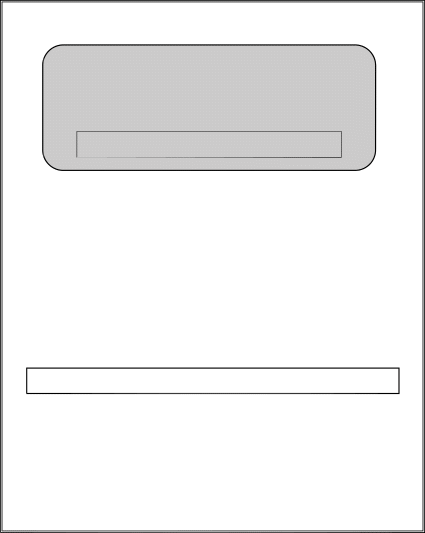

Ages & Stages Questionnaires®:Inventory
For children ages 4 weeks up to 54 months
Introduction and Summary Forms

Public reporting burden of this collection of information is estimated to average 160 minutes per response, including the time for reviewing instructions, searching existing data sources, gathering and maintaining the data needed, and completing and reviewing the collection of information. An agency may not conduct or sponsor, and a person is not required to respond to a collection of information unless it displays a currently valid OMB control number. Send comments regarding this burden estimate or any other aspect of this collection of information, including suggestions for reducing this burden to CDC/ATSDR Information Collection Review Office, 1600 Clifton Road NE, MS D-74, Atlanta, Georgia 30333; ATTN: PRA (0923-XXXX).
The Ages & Stages Questionnaires: Inventory (ASQ:I) asks questions about activities many children learn to do. Each ASQ:I can be used up to four different times in order to monitor your child’s development. Each completion date can be filled in the space provided under Date 1 (1st), Date 2 (2nd), Date 3 (3rd) and Date 4 (4th).
To complete the ASQ: Inventory, please follow these steps:
1. Find your child’s starting point based on their age.
2. Read each question carefully and indicate whether your child is able to do the activity by answering “yes (regularly)”, “sometimes”, or “not yet”.
3. Continue to answer the questions until you reach your child’s stopping point.
4. Please complete these steps for each of the five developmental areas: Communication, Gross Motor, Fine Motor, Problem Solving, and Personal-Social.
Instructions for finding your child’s starting and stopping point are on page 4.
Public
reporting burden of this collection of information is estimated to
average 15 minutes per response, including the time for reviewing
instructions, searching existing data sources, gathering and
maintaining the data needed, and completing and reviewing the
collection of information. An agency may not conduct or sponsor,
and a person is not required to respond to a collection of
information unless it displays a currently valid OMB control
number. Send comments regarding this burden estimate or any other
aspect of this collection of information, including suggestions for
reducing this burden to CDC/ATSDR Information Collection Review
Office, 1600 Clifton Road NE, MS D-74, Atlanta, Georgia 30333;
ATTN: PRA (0923-XXXX).
Public
reporting burden of this collection of information is estimated to
average 160
minutes
per response, including the time for reviewing instructions,
searching existing data sources, gathering and maintaining the data
needed, and completing and reviewing the collection of information.
An agency may not conduct or sponsor, and a person is not required
to respond to a collection of information unless it displays a
currently valid OMB control number. Send comments regarding this
burden estimate or any other aspect of this collection of
information, including suggestions for reducing this burden to
CDC/ATSDR Information Collection Review Office, 1600 Clifton Road
NE, MS D-74, Atlanta, Georgia 30333; ATTN: PRA (0923-XXXX).
®
1

© 2009 Paul H. Brookes Publishing Co.
Pilot Version 2.3 2011 Not for distribution
ASQ™: Inventory For children ages 4 weeks up to 54 months
Child ID #
Program ID #
Family and Child Information
ASQ:Inventory
Please provide the following information.
Child’s name:
Child’s date of birth:
Date(s) ASQ:Inventory completed:
Date 1:
Date 2:
Date 3:
Date 4:
Child’s age at completion:
Date 1:
Date 2:
Date 3:
Date 4:
For children younger than 24 months:
a. Was your child born prematurely? Yes No If yes, how many weeks?
b. If your child was born more than 3 weeks premature, you will need to calculate an adjusted age by subtracting weeks of prematurity from your child’s age. This adjusted age will be your child’s starting point on the ASQ:Inventory.
Child’s Adjusted Age:
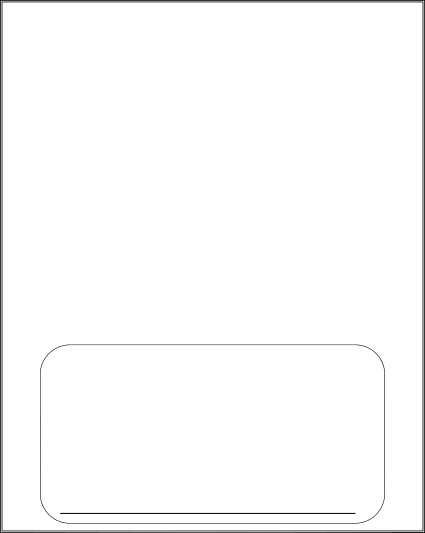 Date
1:
Date
1:
Date 2:
Date 3:
Date 4:
Name of person filling out this questionnaire:
What is your relationship to the child?
Administering program or provider:
Additional Information for Pilot Project (to be completed by agency personnel):
Child’s ID:
Program ID:
Child’s Gender: Male Female
Child’s Race: (Please check all that apply)
Caucasian
Native American
Other:
African American Pacific Islander
Asian
Hispanic
Family receiving subsidized childcare? Yes No
Does child have an identified disability or is child receiving EI/ECSE Services? Yes No
If yes, what is the child’s disability or eligibility category (e.g., Down Syndrome, speech delay)?
®
© 2009 Paul H. Brookes Publishing Co.
Pilot Version 2.3 2011 Not for distribution
Family and Child Information 2
ASQ™: Inventory For children ages 4 weeks up to 54 months
Child ID #
Program ID #
General Developmental Questions
Please mark either a
Y for “Yes”
N for “No”

Public reporting burden of this collection of information is estimated to average 160 minutes per response, including the time for reviewing instructions, searching existing data sources, gathering and maintaining the data needed, and completing and reviewing the collection of information. An agency may not conduct or sponsor, and a person is not required to respond to a collection of information unless it displays a currently valid OMB control number. Send comments regarding this burden estimate or any other aspect of this collection of information, including suggestions for reducing this burden to CDC/ATSDR Information Collection Review Office, 1600 Clifton Road NE, MS D-74, Atlanta, Georgia 30333; ATTN: PRA (0923-XXXX).
in the boxes below:
Section I. For all ages
1. Do you think your child hears well? (For infants, did your child pass the newborn screening?)
If no, explain:
Date 1 Date 2 Date 3 Date 4
2. Does either parent have a family history of childhood deafness or hearing impairment?
If yes, explain:
3. Do you have concerns about your child’s vision?
If yes, explain:
4. Has your child had any medical problems in the last several months?
If yes, explain:
5. Do you have any concerns about your baby’s/child’s behavior?
If yes, explain:
6. Does anything about your child worry you?
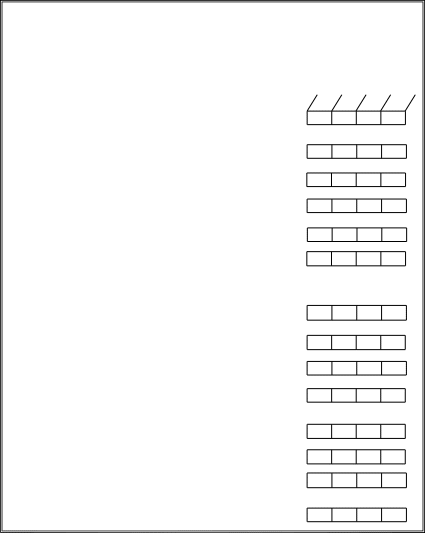 If
yes,
explain:
If
yes,
explain:
Section II. Please answer the questions that match your child’s age
Up to 15 months:
(1-15 m) 1. Does your baby use both hands and both legs equally well?
If no, explain:
( 3-15 m) 2. When you help your baby stand, are his/her feet flat on the surface most of the time?
If no, explain:
(3-15 m) 3. Do you have concerns that your baby is too quiet, or does not make sounds ilke other babies?
If yes, explain:
(11-15 m) 4. Does your baby play with sounds or seem to make words?
If no, explain:
15 months and older:
1. Do you think your child talks like other children his / her age?
If no, explain:
2. Can you understand most of what your child says?
If no, explain:
3. Do you think your child walks, runs, climbs like other children his / her age?
If no, explain:
30 months and older:
1. Can other people understand most of what your child says?
If no, explain:
®
© 2009 Paul H. Brookes Publishing Co.
Pilot Version 2.3 2011 Not for distribution
General Developmental Questions 3
ASQ™: Inventory For children ages 4 weeks up to 54 months
Child ID #
Program ID #
Instruction Page
How to Start and Stop on the ASQ:Inventory?
1. Find your child’s starting point based on his or her age.
For example, in the Communication section, if your child is 15 months, you would start at item #18.
12 up to 18 month children start here
18.
19.
Date 1
 Y
Y
Y
Y
2. Answer the questions.
• Mark “Y” (yes) for activities that you have observed your child doing on a regular basis.
• Mark “S” (sometimes) for activities that your child is just beginning to do.
• Mark “N” (not yet) for activities that you have not yet seen your child do even when given the opportunity.
3. Find your child’s stopping point.
Stop answering questions when you have marked 3 “N”s in a row. (In this example, the child’s stopping point is question #30.) Draw a circle around the 3 “N”s.
4. Look for 3 “Y”s in a row.
Go back and review your responses. There should be at least 3 Y’s in a row from your child’s starting point. Circle the 3 Y’s (e.g. #’s 18, 19, 20 in this example).
IF NOT, go back to the starting point and work backwards one question at a time until there are 3 “Y”s in a row.
5. Please complete these steps for EACH of the
sections of the ASQ:Inventory (Communication, Gross Motor, Fine Motor, Problem Solving, and Personal- Social).
20. Y
21. Y
22. Y
 23. S
23. S
24. S
25. N
26. S
27. S
28. N
29. N
30. N
31.
®
© 2009 Paul H. Brookes Publishing Co.
Pilot Version 2.3 2011 Not for distribution
Instruction Page 4
ASQ™: Inventory For children ages 4 weeks up to 54 months
Child ID #
Program ID #
Communication Scores
(ASQ™:Inventory Communication pages 2-9)
Instructions:
• Total scores for each page.
• Enter subtotal score for each page in table below.
• Add scores from each page for “Total Score”.
• Divide “Total Score” by 130 (total score possible) to calculate “Domain Percent”.
Scoring Guide:
Yes (Y) = 2
Sometimes (S) = 1
Not Yet (N) = 0
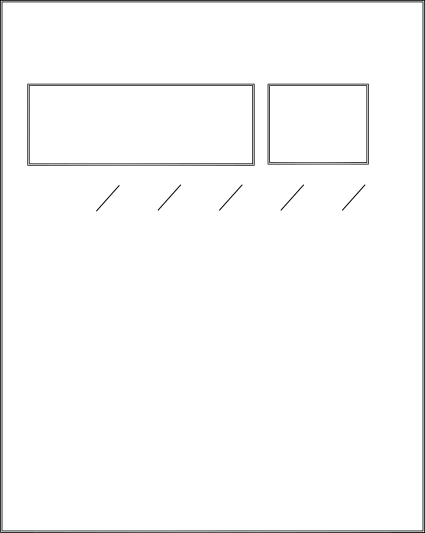 Date
1 Date
2 Date
3 Date
4
Date
1 Date
2 Date
3 Date
4
-
Page
Subtotal
Subtotal
Subtotal
Subtotal
2
3
4
5
6
7
8
9
Total Score
/ 130
/ 130
/ 130
/ 130
Domain
Percent
®
© 2009 Paul H. Brookes Publishing Co.
Pilot Version 2.3 2011 Not for distribution
Communication Scores 5
ASQ™: Inventory For children ages 4 weeks up to 54 months
Child ID #
Program ID #
Gross Motor Scores
(ASQ™:Inventory Gross Motor pages 2-8)
Instructions:
• Total scores for each page.
• Enter subtotal score for each page in table below.
• Add scores from each page for “Total Score”.
• Divide “Total Score” by 130 (total score possible) to calculate “Domain Percent”.
Scoring Guide:
Yes (Y) = 2
Sometimes (S) = 1
Not Yet (N) = 0
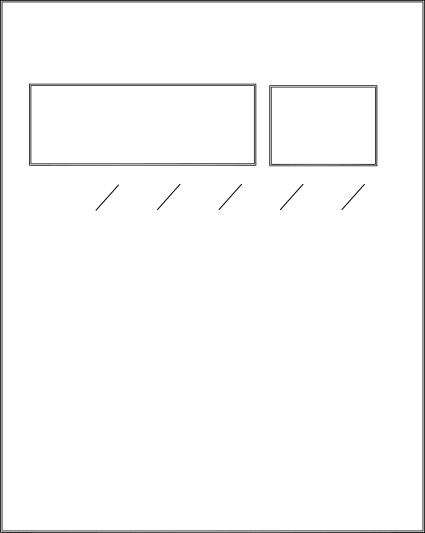 Date
1 Date
2 Date
3 Date
4
Date
1 Date
2 Date
3 Date
4
-
Page
Subtotal
Subtotal
Subtotal
Subtotal
2
3
4
5
6
7
8
Total Score
/ 130
/ 130
/ 130
/ 130
Domain
Percent
®
© 2009 Paul H. Brookes Publishing Co.
Pilot Version 2.3 2011 Not for distribution
Gross Motor Scores 6
ASQ™: Inventory For children ages 4 weeks up to 54 months
Child ID #
Program ID #
Fine Motor Scores
(ASQ™:Inventory Fine Motor pages 2-9)
Instructions:
• Total scores for each page.
• Enter subtotal score for each page in table below.
• Add scores from each page for “Total Score”.
• Divide “Total Score” by 126 (total score possible) to calculate “Domain Percent”.
Scoring Guide:
Yes (Y) = 2
Sometimes (S) = 1
Not Yet (N) = 0
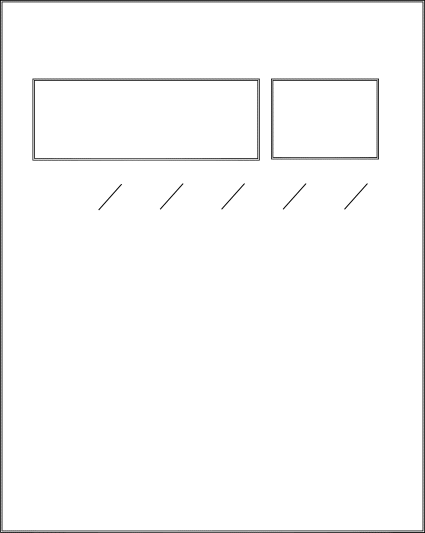 Date
1 Date
2 Date
3 Date
4
Date
1 Date
2 Date
3 Date
4
-
Page
Subtotal
Subtotal
Subtotal
Subtotal
2
3
4
5
6
7
8
9
Total Score
/ 126
/ 126
/ 126
/ 126
Domain
Percent
®
© 2009 Paul H. Brookes Publishing Co.
Pilot Version 2.3 2011 Not for distribution
Fine Motor Scores 7
ASQ™: Inventory For children ages 4 weeks up to 54 months
Child ID #
Program ID #
Problem Solving Scores
(ASQ™:Inventory Problem Solving pages 2-9)
Instructions:
• Total scores for each page.
• Enter subtotal score for each page in table below.
• Add scores from each page for “Total Score”.
• Divide “Total Score” by 136 (total score possible) to calculate “Domain Percent”.
Scoring Guide:
Yes (Y) = 2
Sometimes (S) = 1
Not Yet (N) = 0
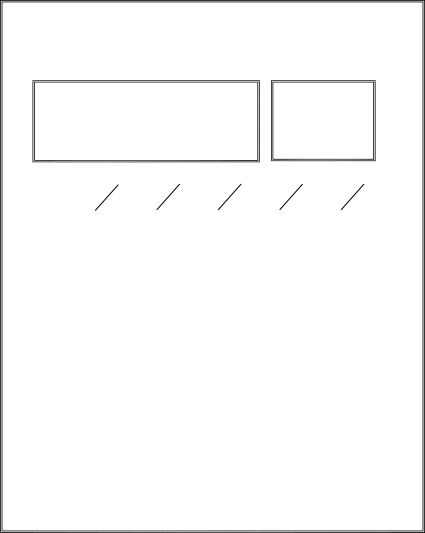 Date
1 Date
2 Date
3 Date
4
Date
1 Date
2 Date
3 Date
4
-
Page
Subtotal
Subtotal
Subtotal
Subtotal
2
3
4
5
6
7
8
9
Total Score
/ 136
/ 136
/ 136
/ 136
Domain
Percent
®
© 2009 Paul H. Brookes Publishing Co.
Pilot Version 2.3 2011 Not for distribution
Problem Solvinng Scores 8
ASQ™: Inventory For children ages 4 weeks up to 54 months
Child ID #
Program ID #
Personal-Social Scores
(ASQ™:Inventory Personal-Social pages 2-8)
Instructions:
• Total scores for each page.
• Enter subtotal score for each page in table below.
• Add scores from each page for “Total Score”.
• Divide “Total Score” by 134 (total score possible) to calculate “Domain Percent”.
Scoring Guide:
Yes (Y) = 2
Sometimes (S) = 1
Not Yet (N) = 0
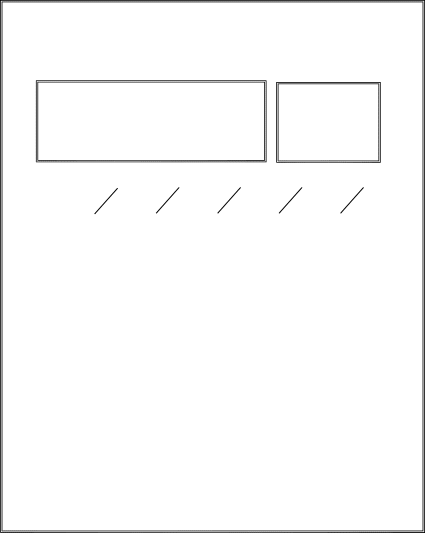 Date
1 Date
2 Date
3 Date
4
Date
1 Date
2 Date
3 Date
4
-
Page
Subtotal
Subtotal
Subtotal
Subtotal
2
3
4
5
6
7
8
Total Score
/ 134
/ 134
/ 134
/ 134
Domain
Percent
®
© 2009 Paul H. Brookes Publishing Co.
Pilot Version 2.3 2011 Not for distribution
Personal-Social Scores 9
ASQ™: Inventory For children ages 4 weeks up to 54 months
Child ID #
Program ID #
Score Summary
To show the child’s progress in each domain, here are the instructions:
1. Fill in the administration date.
2. Transfer the Domain Percent from the ASQ:Inventory Score pages.
3. Plot percentages for each
administration time.
Administration Date
100
Domain
%
60
40
20
Communication
/ / / /
Child’s %
Gross Motor
Fine Motor
Administration Date
/ / / /
Administration Date
/ / / /
100
80
60
Domain
%
20
100
80
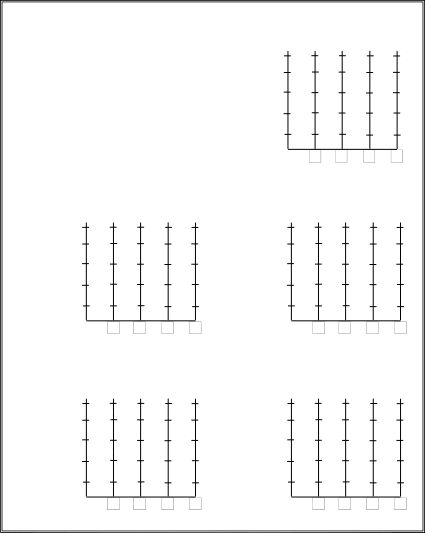 60
60
Domain
%
20
Child’s %
Child’s %
Problem Solving
Personal-Social
Administration Date
/ / / /
Administration Date
/ / / /
100
80
60
Domain
%
20
100
80
Domain
%
40
20
Child’s %
Child’s %
®
© 2009 Paul H. Brookes Publishing Co.
Pilot Version 2.3 2011 Not for distribution
Score Summaries 10
ASQTM: Inventory For children ages 4 weeks up to 54 months
Child ID #
Program ID#
Ages and Stages Questionnaires®: Inventory
(For children ages 4 weeks up to 54 months)
Problem Solving
Instructions for completion:
1. Use the following table to find your child’s starting point based on his/her age.
2. Read each question carefully and check the box that tells whether your child is doing the activity yes (regularly), sometimes, or not yet.
3. Try each activity unless you are certain that your child can already do the item, or you know they cannot yet do the item.
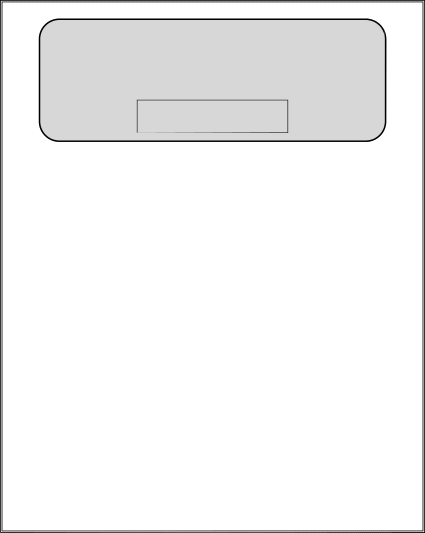 Please
note:
there
may
be
some
activities
that
your
child
used
to
do,
but
has
replaced
with
a
more
advanced
skill
(for
example,
older
children
no
longer
put
toys
in
their
mouths).
An-
swer
these
items
as
“Yes”.
Please
note:
there
may
be
some
activities
that
your
child
used
to
do,
but
has
replaced
with
a
more
advanced
skill
(for
example,
older
children
no
longer
put
toys
in
their
mouths).
An-
swer
these
items
as
“Yes”.
-
Starting points for the Problem Solving domain:
If your child’s age is:
Start with item:
Page:
1 up to 3 months
1
2
3 up to 6 months
3
2
6 up to 9 months
6
2
9 up to 12 months
12
3
12 up to 18 months
17
3
18 up to 24 months
24
4
24 up to 30 months
28
4
30 up to 36 months
34
5
36 up to 45 months
39
6
45 up to 54 months
45
7
Tips for completing the ASQTM:Inventory
• Try to make completing this questionnaire a game that is fun for you and your child.
• Make sure your child is rested, fed, and ready to play.
ASQTM:Inventory
Pilot Version 2.3 2011
Ages & Stages Questionnaires®:Inventory
© 2009 Paul H. Brookes Publishing Co. Pilot Version 2.3 2011 Not for distribution
Problem Solving 1
ASQTM: Inventory For children ages 4 weeks up to 54 months
Child ID #
Program ID#
Problem Solving
Please mark either a:
Y for Yes,
S for Sometimes, and
N for Not Yet
1 up to 3 month babies start here: 1st 2nd 3rd 4th
1. Does your baby look at objects that are 8-10 inches away?
1-2
2. When you move a small toy up and down slowly in front of your baby’s face (about 10 inches away), does your baby follow the toy with his eyes?
4-2
3 up to 6 month babies start here:
3. When you move a toy slowly from side to side in front of your baby’s face (about 10 inches away), does your baby follow the toy with her eyes, sometimes turning her head?
3-2
4. When you move around, does your baby follow you with his eyes?
2-2
5. When you put a toy in her hand, does your baby look at it?
4-4
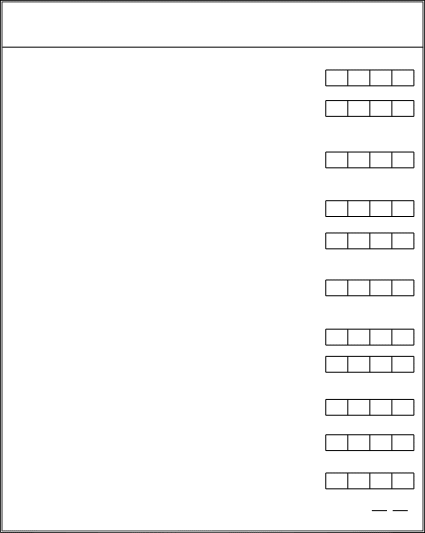 6
up
to
9
month
babies
start
here:
6
up
to
9
month
babies
start
here:
6. When you hold your baby in a sitting position, does she look at a toy (about the size of a cup or rattle) that you place on the table or floor in front of her?
5-2
7. When you put a toy in his hand, does your baby put the toy in his mouth?
5-4
8. When you dangle a toy above your baby while he is lying on his back, does he wave his arms toward the toy?
6-2
9. Does your baby pick up a toy and put it in his mouth?
4-6
10. When your baby is on his back, does he turn his head to look for a toy when he drops it? (If he already picks it up, mark “yes” for this item.)
2-6
11. When your baby is on her back, does she try to get a toy she has dropped if she can see it?
3-6
Subtotal
Remember to stop when you have marked ‘Not Yet’ 3 times in a row.
ASQTM:Inventory
Pilot Version 2.3 2011
Ages & Stages Questionnaires®: Inventory
© 2009 Paul H. Brookes Publishing Co. Pilot Version 2.3 2011 Not for distribution
Problem Solving 2
ASQTM: Inventory For children ages 4 weeks up to 54 months
Child ID #
Program ID#
Problem Solving
9 up to 12 month babies start here:
12. Does your baby play by banging a toy up and down on the floor or table?
6-6
13. When a toy is in front of your baby, does she reach for it with both hands?
1-6
14. Does your baby pass a toy back and forth from one hand to the other?
5-6
15. When holding a toy in his hand, does your baby bang it against another toy on the table?
6-8
16. Does your baby pick up two small toys, one in each hand, and hold onto them for about 1 minute?
5-8
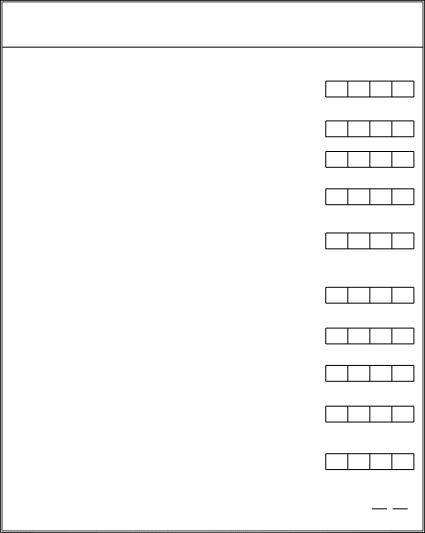 12
up
to
18
month
children
start
here:
12
up
to
18
month
children
start
here:
17. After watching you hide a small toy under a piece of paper or cloth, does your child find it? (Be sure the toy is completely hidden.)
6-10
18. While holding a small toy in each hand, does your child clap the toys together (like “Pat-a-cake”)?
4-10
19. Does your child poke at or try to get a crumb or Cheerio that is inside a clear bottle (such as a plastic soda-pop bottle or baby bottle)?
5-10
20. If you put a small toy into a bowl or box, does your child copy you by putting in a toy, although she may not let go of it? (If she already lets go of the toy into a bowl or box, mark “yes” for this item.)
4-12
21. Does your child drop two small toys, one after the other, into a container like a bowl or box? (You may show him how to do it.)
5-12
Please mark either a:
Y for Yes,
S for Sometimes, and
N for Not Yet
1st 2nd 3rd 4th
Subtotal
Remember to stop when you have marked ‘Not Yet’ 3 times in a row.
ASQTM:Inventory
Pilot Version 2.3 2011
Ages & Stages Questionnaires®: Inventory
© 2009 Paul H. Brookes Publishing Co. Pilot Version 2.3 2011 Not for distribution
Problem Solving 3
ASQTM: Inventory For children ages 4 weeks up to 54 months
Child ID #
Program ID#
Problem Solving
22. If you give your child a bottle, spoon, or pencil upside down, does she turn it right side up so that she can use it properly?
4-20
23. After you scribble back and forth on paper with a crayon (or a pencil or pen), does your child copy you by scribbling? (If she already scribbles on her own, mark “yes” for this item.)
6-12
18 up to 24 month children start here:
24. Does your child drop several (3 or more) small toys, one after another, into a container like a bowl or box? (You may show her how to do it.)
5-14
25. Can your child drop a crumb or Cheerio into a small, clear bottle (such as a plastic soda-pop bottle or baby bottle)?
4-14
26. Without your showing him how, does your child scribble back and forth when you give him a crayon (or pencil or pen)?
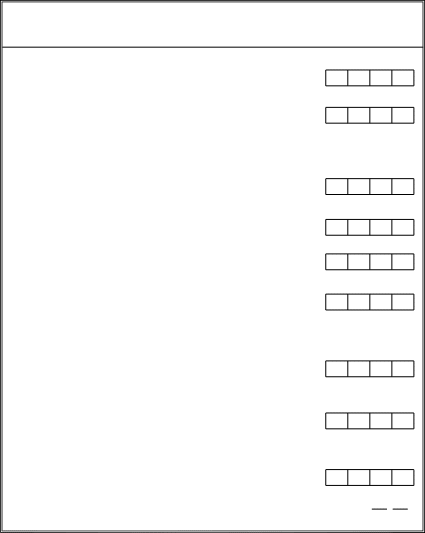 5-16
5-16
27. After a crumb or Cheerio is dropped into a small, clear bottle, does your child turn the bottle upside down to dump it out? (You may show him how.)
6-16
Please mark either a:
Y for Yes,
S for Sometimes, and
N for Not Yet
1st 2nd 3rd 4th
24 up to 30 month children start here:
28. After a crumb or Cheerio is dropped into a small, clear bottle, does your child turn the bottle upside down to dump out the crumb or Cheerio? (Do not show her how.)
6-18
29. If you do any of the following gestures, does your child copy at least one of them?
3-20
a. Open and close your mouth b. Blink your eyes c. Pull on your earlobe d. Pat your cheek
30. Does your child put things away where they belong? For example, does he know his toys belong on the toy shelf, his blanket goes on his bed, and dishes go in the kitchen?
4-24
Subtotal
Remember to stop when you have marked ‘Not Yet’ 3 times in a row.
ASQTM:Inventory
Pilot Version 2.3 2011
Ages & Stages Questionnaires®: Inventory
© 2009 Paul H. Brookes Publishing Co. Pilot Version 2.3 2011 Not for distribution
Problem Solving 4
ASQTM: Inventory For children ages 4 weeks up to 54 months
Child ID #
Program ID#
Problem Solving
31. Does your child pretend objects are something else? For example, does your child hold a cup to his ear, pretending it is a telephone? Does he put a box on his head, pretending it is a hat? Does he use a block or small toy to stir food?
3-22
Please mark either a:
Y for Yes,
S for Sometimes, and
N for Not Yet
1st 2nd 3rd 4th
32. While your child watches, line up four objects like blocks or cars in a row. Does your child copy or imitate you and line up at least two blocks side by side? (You can also use spools of thread, small boxes, or other toys.)
5-20
33. If your child wants something he cannot reach, does he find a chair or box to stand on to reach it (for example, to get a toy on a counter or to “help” you in the kitchen)?
6-20
30 up to 36 month children start here:
34. After you have shown your child how, does he try to get a small toy that is slightly out of reach by using a spoon, stick, or similar tool?
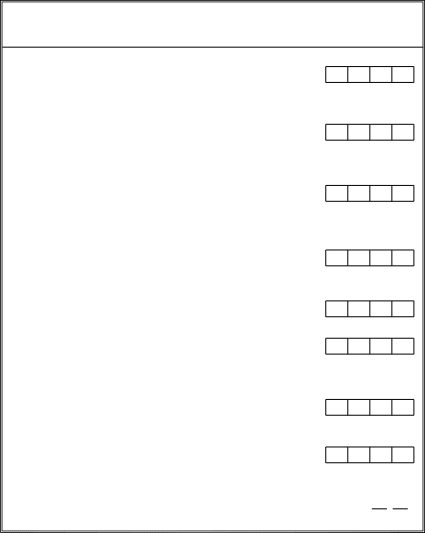 6-14
6-14
35. When looking in the mirror, ask “Where is ?” (Use your child’s name.) Does your child point to his image in the mirror?
3-27
36. While your child watches, line up four objects like blocks or cars in a row. Does your child copy or imitate you and line up four objects in a row? (You can also use spools
of thread, small boxes, or other toys.)
6-24
37. Show your child how to make a bridge with blocks, boxes, or cans, like the example. Does your child copy you by making one like it?
5-36
38. When you say, “Say ‘seven three,’” does your child repeat just the two numbers in the same order? Do not repeat the numbers. If necessary, try another pair of numbers and say, “Say ‘eight two.’” Your child must repeat just one series of two numbers for you to answer “yes” to this question.
5-30
Subtotal
Remember to stop when you have marked ‘Not Yet’ 3 times in a row.
ASQTM:Inventory
Pilot Version 2.3 2011
Ages & Stages Questionnaires®: Inventory
© 2009 Paul H. Brookes Publishing Co. Pilot Version 2.3 2011 Not for distribution
Problem Solving 5
ASQTM: Inventory For children ages 4 weeks up to 54 months
Child ID #
Program ID#
Problem Solving
36 up to 45 month children start here:
39. Does your child dress up and “play-act,” pretending to be someone or something else? For example, your child may dress up in different clothes and pretend to be a mommy, daddy, brother, or sister, or an imaginary animal or figure.
6-42
40. When you point to the figure and ask your child, “What is this?” does your child say a word that means a person or something similar? (Mark “yes” for responses like “snowman,” “boy,” “man,” “girl,” “Daddy”, “spaceman” and “monkey”.)
6-27
41. Without your giving help by pointing, does your child follow three different directions using the words “under,” “between,” and “middle”? For example, ask your child to put a shoe “under the couch.” Then ask her to put the ball “between the chairs” and the book “in the middle of the table.”
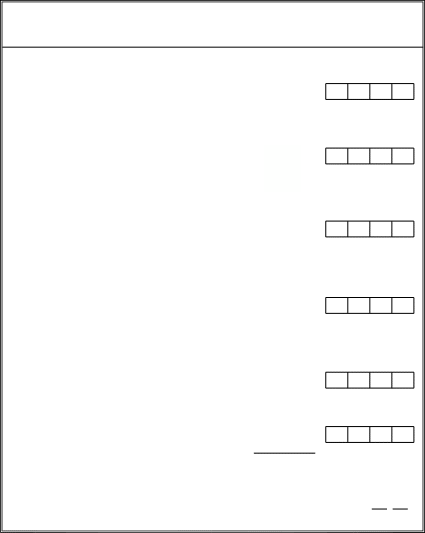 3-48
3-48
42. When you say, “Say ‘five eight three,’” does your child repeat just the three numbers in the same order? Do not repeat the numbers. If necessary, try another series of numbers and say, “Say ‘six nine two.’” (Your child must repeat just one series of three numbers for you to answer “yes” to this question.)
6-36
43. After your child draws a “picture,” even a simple scribble, does she tell you what she drew? (You may say, “Tell me about your picture,” or ask, “What is this?” to prompt her.)
6-30
Please mark either a:
Y for Yes,
S for Sometimes, and
N for Not Yet
1st 2nd 3rd 4th
44. After watching you draw a line from the top of the paper to the bottom with a crayon (or pencil or pen), does your child copy you by drawing a single line on the paper in any direction? (Mark “not yet” if your child scribbles back and forth.)
5-18
Count as “yes”
Count as “not yet”
Subtotal
Remember to stop when you have marked ‘Not Yet’ 3 times in a row.
ASQTM:Inventory
Pilot Version 2.3 2011
Ages & Stages Questionnaires®: Inventory
© 2009 Paul H. Brookes Publishing Co. Pilot Version 2.3 2011 Not for distribution
Problem Solving 6
ASQTM: Inventory For children ages 4 weeks up to 54 months
Child ID #
Program ID#
Problem Solving
45 up to 54 month children start here:
45. When asked, “Which circle is the smallest?” does your child point to the smallest circle? (Ask this question without providing help by pointing, ges- turing, or looking at the smallest circle.)
5-42
46. When shown objects and asked, “What color is this?” does your child name five different colors like red, blue, yellow, orange, black, white, or pink? (Mark “yes” only if your child answers the question correctly using five colors.)
4-48
47. If you place five objects in front of your child, can he count them by say- ing, “one, two, three, four, five,” in order? (Ask this question without pro- viding help by pointing, gesturing, or naming.)
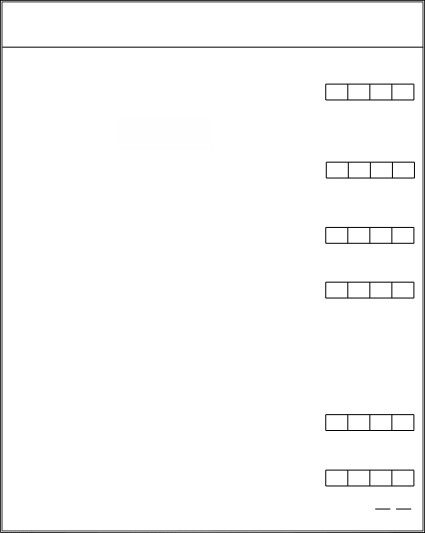 6-48
6-48
48. Does your child know the following six words for shapes? For example, your child says, "That's a square," when pointing to a box. If she knows at least 3 shapes mark "sometimes".
29p
Please mark either a:
Y for Yes,
S for Sometimes, and
N for Not Yet
a. circle c. diamond e. rectangle b. triangle d. square f. star.
49. Ask your child which of these is the biggest and which is the smallest.
Then say, "a house," "a car," and "a cup." Can you child tell you which one is the biggest and smallest?
21p
50. Show the 26 printed letters of the alphabet to your child. Can your child correctly name more than 10 of them? If the child can name 7, mark "sometimes."
27p
Subtotal
Remember to stop when you have marked ‘Not Yet’ 3 times in a row.
ASQTM:Inventory
Pilot Version 2.3 2011
Ages & Stages Questionnaires®: Inventory
© 2009 Paul H. Brookes Publishing Co. Pilot Version 2.3 2011 Not for distribution
Problem Solving 7
ASQTM: Inventory For children ages 4 weeks up to 54 months
Child ID #
Program ID#
Problem Solving
51. Does your child finish the following sentences using a word that means the opposite of the word that is italicized? For example: “A rock is hard, and a pillow is soft.” Please write your child’s responses below:
A cow is big, and a mouse is . Ice is cold, and fire is .
We see stars at night, and we see the sun during the . When I throw the ball up, it comes .
(Mark “yes” if she finishes three of four sentences correctly. Mark
“sometimes” if she finishes two of four sentences correctly.)
4-60
52. Does your child know the names of numbers? (Mark “yes” if he identifies the three numbers below. Mark “sometimes” if he identifies two numbers.)
6-54
Please mark either a:
Y for Yes,
S for Sometimes, and
N for Not Yet
1st 2nd 3rd 4th
3 1 2
53. Does your child name at least four letters in her name? Point to the letters and ask, “What letter is this?” (Point to the letters out of order.)
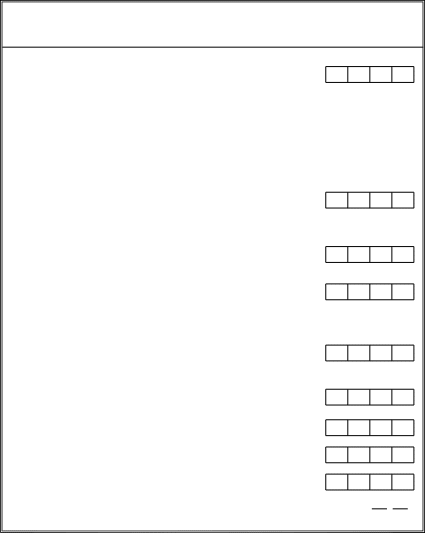 6-60
6-60
54. Does your child know printed numbers from 1 to 10? For example, when you point to a number in a book, on cards, or on road signs, does your child correctly name the numbers? ( If your child knows at least 5 numbers,
mark "sometimes".)
31p
55. Does your child count up to 15 without making mistakes? If so, mark “yes.” If your child counts to 12 without making mistakes, mark “sometimes.”
5-54
56. Can your child show you her left hand or her left foot?
22p
57. Does your child know the sounds of 5 of these letters? s, t, k, m, p, c, f, j.
28p
58. Does your child count up to 20?
9p
59. Put a penny, nickel, and dime in front of your child. Can your child point to the penny?
13p
Subtotal
Remember to stop when you have marked ‘Not Yet’ 3 times in a row.
ASQTM:Inventory
Pilot Version 2.3 2011
Ages & Stages Questionnaires®: Inventory
© 2009 Paul H. Brookes Publishing Co. Pilot Version 2.3 2011 Not for distribution
Problem Solving 8
ASQTM: Inventory For children ages 4 weeks up to 54 months
Child ID #
Program ID#
Problem Solving
60. Does your child say the days of the seven week in the correct order?
14p
Please mark either a:
Y for Yes,
S for Sometimes, and
N for Not Yet
1st 2nd 3rd 4th
61. Ask your child what day comes before and after Friday, does your child answer correctly? Mark "sometimes" if your child can name one of the days.
15p
62. Ask your child what is 6 minus (or take away) 1, 4 minus 2, and 8 minus 3.
Does your child correctly subtract one number from another? They can use their fingers to count.
16p
63. Does your child tell you if a spoken or printed word has the same or differ- ent beginning and ending sounds? For example, CAR and CAKE have the same beginning sounds. BEG and DOG have the same end sounds.
MAMA and LLAMA have different beginning sounds. TOP and TOY
have different ending sounds.
 30p
30p
64. Can your child count past “40”?
10p
65. Does your child correctly spell 3-letter words? For example, “cat,” “dog,” “pen”.
18p
66. Can your child tell you all 12 months of the year? Mark “Sometimes” if your child can tell you more than 6 months of the year.
19p
67. Ask your child what is 4 plus 2, 3 plus 5, 7 plus 1. Does your child cor- rectly add the numbers? They can use their fingers to count.
17p
68. Can your child count to 100 by 10’s?
11p
Subtotal
Remember to stop when you have marked ‘Not Yet’ 3 times in a row.
ASQTM:Inventory
Pilot Version 2.3 2011
Ages & Stages Questionnaires®: Inventory
© 2009 Paul H. Brookes Publishing Co. Pilot Version 2.3 2011 Not for distribution
Problem Solving 9
ASQTM: Inventory For children ages 4 weeks up to 54 months
Child ID #
Program ID#
Ages and Stages Questionnaires®: Inventory
(For children ages 4 weeks up to 54 months)
Communication
Instructions for completion:
1. Use the following table to find your child’s starting point based on his/her age.
2. Read each question carefully and check the box that tells whether your child is doing the activity yes (regularly), sometimes, or not yet.
3. Try each activity unless you are certain that your child can already do the item, or you know they cannot yet do the item.
 Please
note:
there
may
be
some
activities
that
your
child
used
to
do,
but
has
replaced
with
a
more
advanced
skill
(for
example,
older
children
may start talking instead of cooing).
An-
Please
note:
there
may
be
some
activities
that
your
child
used
to
do,
but
has
replaced
with
a
more
advanced
skill
(for
example,
older
children
may start talking instead of cooing).
An-
-
Starting points for the Communication domain:
If your child’s age is:
Start with item:
Page:
1 up to 3 months
1
2
3 up to 6 months
4
2
6 up to 9 months
9
2
9 up to 12 months
13
3
12 up to 18 months
18
3
18 up to 24 months
21
3
24 up to 30 months
25
4
30 up to 36 months
29
4
36 up to 45 months
34
5
45 up to 54 months
40
6
Tips for completing the ASQTM:Inventory
• Try to make completing this questionnaire a game that is fun for you and your child.
• Make sure your child is rested, fed, and ready to play.
ASQTM:Inventory
Pilot Version 2.3 2011
Ages & Stages Questionnaires®:Inventory
© 2009 Paul H. Brookes Publishing Co. Pilot Version 2.3 2011 Not for distribution
Communication 1
ASQTM: Inventory For children ages 4 weeks up to 54 months
Child ID #
Program ID#
Communication
Please mark either a:
Y for Yes,
S for Sometimes, and
N for Not Yet
1 up to 3 month babies start here: 1st 2nd 3rd 4th
1. Does your baby sometimes make throaty or gurgling sounds?
1-2
2. After you have been out of sight, does your baby smile or get excited when she sees you?
6-2
3. Does your baby make cooing sounds such as “ooo,” “gah,” and “aah”?
2-2
3 up to 6 month babies start here:
4. Does your baby make high-pitched squeals?
4-4
5. Does your baby smile when you talk to him?
4-2
6. When you speak to your baby, does she make sounds back to you?
3-2
 7. Does
your baby laugh?
7. Does
your baby laugh?
5-4
8. Does your baby make sounds when looking at toys or people?
6-4
6 up to 9 month babies start here:
9. If you call your baby when you are out of sight, does she look in the direction of your voice?
3-6
10. When a loud noise occurs, does your baby turn to see where the sound came from?
4-6
11. Does your baby chuckle softly?
5-2
12. When playing with sounds, does your baby make grunting, growling, or other deep-toned sounds?
2-6
Subtotal
Remember to stop when you have marked ‘Not Yet’ 3 times in a row.
ASQ
TM:Inventory
Ages & Stages Questionnaires®:Inventory
© 2009 Paul H. Brookes Publishing Co.
Communication 2
Pilot Version 2.3 2011
Pilot Version 2.3 2011 Not for distribution
ASQTM: Inventory For children ages 4 weeks up to 54 months
Child ID #
Program ID#
Communication
9 up to 12 month babies start here:
13. Does your baby respond to the tone of your voice and stop his activity at least briefly when you say “no-no” to him?
5-8
14. Does your baby make sounds like “da,” “ga,” “ka,” and “ba”?
5-6
15. If you copy the sounds your baby makes, does your baby repeat the same sounds back to you?
6-6
16. Does your baby make two similar sounds like “ba-ba,” “da-da,” or “ga- ga”? (The sounds do not need to mean anything.)
6-8
17. Does your baby stop crying when she hears a voice other than yours?
3-4
 12
up
to
18
month
children
start
here:
12
up
to
18
month
children
start
here:
18. If you ask your child to, does he play at least one nursery game even if you don’t show him the activity yourself (such as “bye-bye"," Peek-a-boo,” “clap your hands,” “So Big”)?
4-10
19. Does your child point to, pat, or try to pick up pictures in a book?
4-14
20. When you ask, “Where is the ball (hat, shoe, etc.)?” does your child look at the object? (Make sure the object is present. Mark “yes” if he knows one object.)
5-12
18 up to 24 month children start here:
21. Does your child follow one simple command, such as “Come here”, “Give it to me”, or “Put it back”, without your using gestures?
5-10
22. Does your child say three words, such as “Mama”, “Dada” and “Baba”? (A “word” is a sound or sounds your child says consistently to mean someone or something.)
6-10
Please mark either a:
Y for Yes,
S for Sometimes, and
N for Not Yet
1st 2nd 3rd 4th
Subtotal
Remember to stop when you have marked ‘Not Yet’ 3 times in a row.
ASQ
TM:Inventory
Ages & Stages Questionnaires®:Inventory
© 2009 Paul H. Brookes Publishing Co.
Communication 3
Pilot Version 2.3 2011
Pilot Version 2.3 2011 Not for distribution
ASQTM: Inventory For children ages 4 weeks up to 54 months
Child ID #
Program ID#
Communication
23. When your child wants something, does he tell you by pointing to it?
6-12
24. Does your child shake his head when he means “no” or “yes”?
3-14
24 up to 30 month children start here:
25. Does your child say four or more words in addition to “Mama” and
“Dada”?
5-14
26. Without your giving him clues by pointing or using gestures, can your child carry out at least three of these kinds of directions?
5-20
a. “Put the toy on the table.” d. “Find your coat.” b. “Close the door.” e. “Take my hand.” c. “Bring me a towel.” f. “Get your book.”
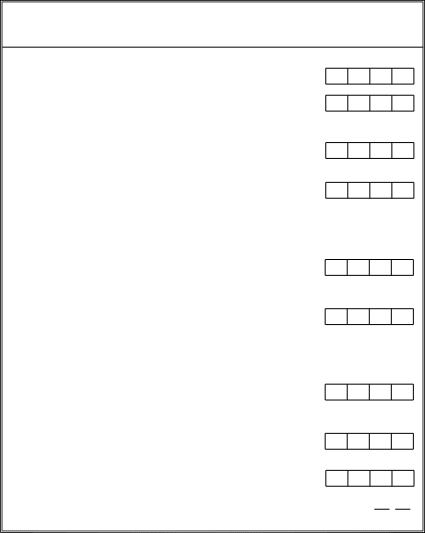 27.
When
you ask him
to,
does your child go into another room
to
find a familiar
toy or object?
(You
might
ask, “Where
is your ball?”
or say, “Bring me
your coat” or “Go get your blanket.”)
27.
When
you ask him
to,
does your child go into another room
to
find a familiar
toy or object?
(You
might
ask, “Where
is your ball?”
or say, “Bring me
your coat” or “Go get your blanket.”)
6-14
28. When you ask your child to point to her nose, eyes, hair, feet, ears, and so forth, does your child correctly point to at least seven body parts? (She can point to part/s of herself, you, or a doll. Mark “sometimes” if she correctly points to at least three different body parts.)
3-22
Please mark either a:
Y for Yes,
S for Sometimes, and
N for Not Yet
1st 2nd 3rd 4th
30 up to 36 month children start here:
29. Without your showing him, does your child point to the correct picture when you say, “Show me the kitty” or ask, “Where is the dog?” (He needs to identify only one picture correctly.)
5-18
30. Does your child say eight or more words in addition to “Mama” and
“Dada”?
6-16
31. If you point to a picture of a ball (kitty, cup, hat, etc.) and ask your child, “What is this?” does your child correctly name at least one picture?
4-20
Subtotal
Remember to stop when you have marked ‘Not Yet’ 3 times in a row.
ASQ
TM:Inventory
Ages & Stages Questionnaires®:Inventory
© 2009 Paul H. Brookes Publishing Co.
Communication 4
Pilot Version 2.3 2011
Pilot Version 2.3 2011 Not for distribution
ASQTM: Inventory For children ages 4 weeks up to 54 months
Child ID #
Program ID#
Communication
32. Without giving your child help by pointing or using gestures, ask him to “put the book on the table” and “put the shoe under the chair.” Does your child carry out both of these directions correctly?
6-27
33. Does your child say 15 or more words in addition to “Mama” and “Dada”?
4-22
Please mark either a:
Y for Yes,
S for Sometimes, and
N for Not Yet
1st 2nd 3rd 4th
36 up to 45 month children start here:
34. Show your child how a zipper on a coat moves up and down, and say, “See, this goes up and down.” Put the zipper to the middle, and ask your child to move the zipper down. Return the zipper to the middle, and ask your child to move the zipper up. Do this several times, placing the zipper in the middle before asking your child to move it up or down. Does your child consistently move the zipper up when you say “up” and down when you say “down”?
5-33
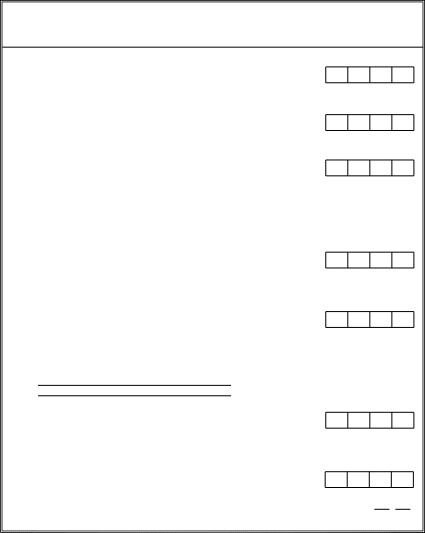 35.
Does
your child imitate
a two-word sentence?
For
example,
when you say a two-word phrase, such as “Mama
eat,”
“Daddy play,” “Go home,”
or “What’s
this?”
does your child say both
words back to you?
(Mark
“yes” even if his words are difficult
to understand.)
35.
Does
your child imitate
a two-word sentence?
For
example,
when you say a two-word phrase, such as “Mama
eat,”
“Daddy play,” “Go home,”
or “What’s
this?”
does your child say both
words back to you?
(Mark
“yes” even if his words are difficult
to understand.)
5-16
36. Does your child say two or three words that represent different ideas together, such as “See dog,” “Mommy come home,” or “Kitty gone”? (Don’t count word combinations that express one idea, such as “bye-bye,” “all gone,” “all right,” and “What’s that?”)
6-18
Please give an example of your child’s word combinations:
37. When looking at a picture book, does your child tell you what is happening or what action is taking place in the picture (for example, “barking,” “running,” “eating,” and “crying”)? You may ask, “What is the dog (or
boy) doing?”
6-30
38. When you ask, “What is your name?” does your child say his first name or nickname?
6-33
Subtotal
Remember to stop when you have marked ‘Not Yet’ 3 times in a row.
ASQ
TM:Inventory
Ages & Stages Questionnaires®:Inventory
© 2009 Paul H. Brookes Publishing Co.
Communication 5
Pilot Version 2.3 2011
Pilot Version 2.3 2011 Not for distribution
ASQTM: Inventory For children ages 4 weeks up to 54 months
Child ID #
Program ID#
Communication
39. Does your child correctly use at least two words like “me,” “I,” “mine,”
and “you”?
5-22
Please mark either a:
Y for Yes,
S for Sometimes, and
N for Not Yet
1st 2nd 3rd 4th
45 up to 54 month children start here:
40. Does your child make sentences that are three or four words long?
5-27
Please give an example:
41. Without your giving help by pointing or repeating directions, does your child follow three directions that are unrelated to one another? Give all three directions before your child starts. For example, you may ask your child, “Clap your hands, walk to the door, and sit down,” or “Give me the pen, open the book, and stand up.”
5-42
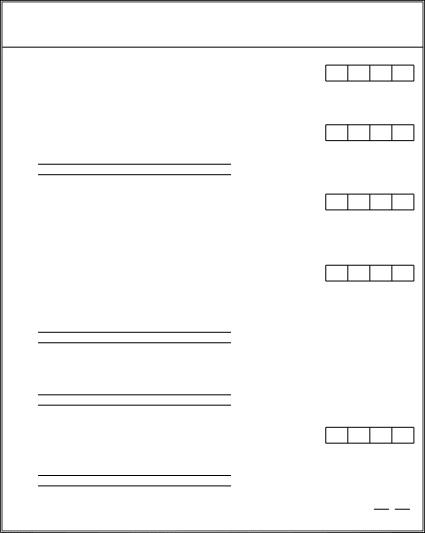 42.
Does
your child answer the following questions? (Mark “sometimes”
if your child answers only one question.)
42.
Does
your child answer the following questions? (Mark “sometimes”
if your child answers only one question.)
“What do you do when you are hungry?” (Acceptable answers include: “get food,” “eat,” “ask for something to eat,” and “have a snack.”)
Please write your child’s response:
“What do you do when you are tired?” (Acceptable answers include “take a nap,” “rest,” “go to sleep,” “go to bed,” “lie down,” and “sit down.”)
Please write your child’s response:
2-48
43. Does your child use four- and five-word sentences? For example, does your child say, “I want the car”?
5-54
Please write an example:
Subtotal
Remember to stop when you have marked ‘Not Yet’ 3 times in a row.
ASQ
TM:Inventory
Ages & Stages Questionnaires®:Inventory
© 2009 Paul H. Brookes Publishing Co.
Communication 6
Pilot Version 2.3 2011
Pilot Version 2.3 2011 Not for distribution
ASQTM: Inventory For children ages 4 weeks up to 54 months
Child ID #
Program ID#
Communication
44. Does your child name at least three items from a common category? For example, if you say to your child, “Tell me some things that you can eat,” does your child answer with something like “cookies, eggs, and cereal”? Or if you say, “Tell me the names of some animals,” does your child an- swer with something like, “cow, dog, and elephant”?
1-48
Please mark either a:
Y for Yes,
S for Sometimes, and
N for Not Yet
1st 2nd 3rd 4th
45. Does your child use endings of words, such as “-s,” “-ed,” and “-ing”? For example, does your child say things like, “I see two cats,” “I am playing,” or “I kicked the ball”?
4-48
46. After hearing new words, does your child try to use them in conversation?
6p
47. Does your child make her voice go high at the end of a sentence that is a question?
19p
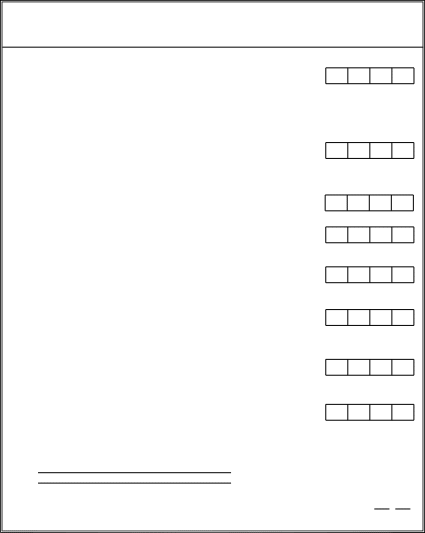 48.
Does
your child use words to describe things? For example,
your child says, "Throw the big ball," or "I want the
red pepper."
48.
Does
your child use words to describe things? For example,
your child says, "Throw the big ball," or "I want the
red pepper."
14p
49. Does your child talk about things that are going to occur in the future? For example, your child says, "We are going to the zoo tomorrow."
21p
50. When your child talks on the phone, can other people understand what she says?
4p
51. When talking about something that already happened, does your child use words that end in “-ed,” such as “walked”, “jumped”, or “played”? Ask your child questions, such as “How did you get to the store?” (“We walked.”) “What did you do at your friend’s house?” (“We played.”)
6-54
Please write an example:
Subtotal
Remember to stop when you have marked ‘Not Yet’ 3 times in a row.
ASQ
TM:Inventory
Ages & Stages Questionnaires®:Inventory
© 2009 Paul H. Brookes Publishing Co.
Communication 7
Pilot Version 2.3 2011
Pilot Version 2.3 2011 Not for distribution
ASQTM: Inventory For children ages 4 weeks up to 54 months
Child ID #
Program ID#
Communication
52. Does your child tell you at least two things about common objects? For example, if you say to your child, “Tell me about your ball,” does she say something like, “It’s round. I throw it. It’s big?”
3-48
Please mark either a:
Y for Yes,
S for Sometimes, and
N for Not Yet
1st 2nd 3rd 4th
53. Does your child use at least 5 words to describe position? For example, does she use words such as "above," "across," "around," "between," "below," "near," "over," and "through".
8p
54. Does your child use 5 words to describe how things feel? For example, does she use words like soft, hard, bumpy, rough, smooth, shimmy, or scratchy?
2p
55. Does your child use all of the words in a sentence (for example, “a,” “the,” “am,” “is,” and “are”) to make complete sentences, such as “I am going to the park,” or “Is there a toy to play with?” or “Are you coming, too?”
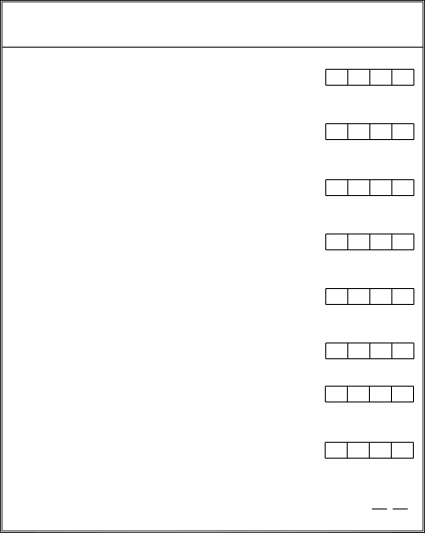 6-42
6-42
56. Does your child use words to talk about how things are different from one another? For example, your child says, "I have the biggest bowl of ice cream," "My car is best," or "She is the strongest."
15p
57. Does your child talk about things that happened in the past using at least 3 irregular verbs such as came, did, went, ran, sat, and fell?
20p
58. Does your child use words that connect other words such as “and,” “but,” “because,” “if,” and “or”? For example, your child says, "We could play or take a nap."
17p
59. Does your child ask you to explain words she does not understand?
5p
Subtotal
Remember to stop when you have marked ‘Not Yet’ 3 times in a row.
ASQ
TM:Inventory
Ages & Stages Questionnaires®:Inventory
© 2009 Paul H. Brookes Publishing Co.
Communication 8
Pilot Version 2.3 2011
Pilot Version 2.3 2011 Not for distribution
ASQTM: Inventory For children ages 4 weeks up to 54 months
Child ID #
Program ID#
Communication
60. Does your child repeat the sentences shown below back to you, without
any mistakes? (Read the sentences one at a time. You may repeat each sen- tence one time. Mark “yes” if your child repeats both sentences without mistakes or “sometimes” if your child repeats one sentence without mis- takes.)
6-60
Please mark either a:
Y for Yes,
S for Sometimes, and
N for Not Yet
1st 2nd 3rd 4th
Jane hides her shoes for Maria to find. Al read the blue book under his bed.
61. When you ask, “What is your name?” does your child say both her first and last names?
6-36
62. Here are examples of five things that have irregular plural endings: man→men, mouse→mice, child→children, goose→geese, and tooth→teeth. Does your child say at least 3 of these or other similar words correctly?
 10p
10p
63. Can your child tell you all the steps in a family routine? For example, if you ask her to tell you all the steps to wash her hands, your child says, "I turn on the water, get some soap, wash my hands, turn off the water and dry my hands.”
1p
64. After reading a new story to your child, can your child tell you the begin- ning, middle, and ending of the story? (You can help the child by saying, "How does the story begin?")
7p
65. Does your child use comparison words, such as “heavier,” “stronger”, or
“shorter”? Ask your child questions, such as “A car is big, but a bus is
” (bigger); “A cat is heavy, but a man is ” (heavier); “A TV is small, but a book is ” (smaller)
4-60
Please write an example :
Subtotal
Remember to stop when you have marked ‘Not Yet’ 3 times in a row.
ASQ
TM:Inventory
Ages & Stages Questionnaires®:Inventory
© 2009 Paul H. Brookes Publishing Co.
Communication 9
Pilot Version 2.3 2011
Pilot Version 2.3 2011 Not for distribution
ASQTM: Inventory For children ages 4 weeks up to 54 months
Child ID #
Program ID#
Ages & Stages Questionnaires®:Inventory
(For children ages 4 weeks up to 54 months)
Fine Motor
Instructions for completion:
1. Use the following table to find your child’s starting point based on his/her age.
2. Read each question carefully and check the box that tells whether your child is doing the activity yes (regularly), sometimes, or not yet.
3. Try each activity unless you are certain that your child can already do the item, or you know they cannot yet do the item.
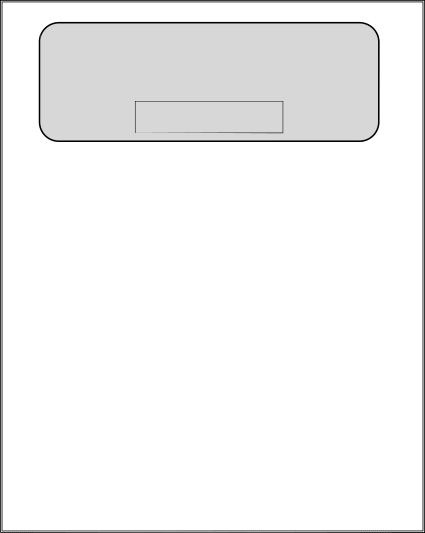 Please
note:
there
may
be
some
activities
that
your
child
used
to
do,
but
has
replaced
with
a
more
advanced
skill
(for
example,
older
children
no
longer
have
their
hands
tightly
closed
when
they
are
awake).
Answer
these
items
as
“Yes”.
Please
note:
there
may
be
some
activities
that
your
child
used
to
do,
but
has
replaced
with
a
more
advanced
skill
(for
example,
older
children
no
longer
have
their
hands
tightly
closed
when
they
are
awake).
Answer
these
items
as
“Yes”.
-
Starting points for the Fine Motor domain:
If your child’s age is:
Start with item:
Page:
1 up to 3 months
1
2
3 up to 6 months
5
2
6 up to 9 months
10
2
9 up to 12 months
14
3
12 up to 18 months
19
3
18 up to 24 months
23
4
24 up to 30 months
26
4
30 up to 39 months
30
5
39 up to 54 months
34
5
Tips for completing the ASQTM:Inventory
• Try to make completing this questionnaire a game that is fun for you and your child.
• Make sure your child is rested, fed, and ready to play.
ASQTM:Inventory
Pilot Version 2.3 2011
Ages & Stages Questionnaires®:Inventory
© 2009 Paul H. Brookes Publishing Co. Pilot Version 2.3 2011 Not for distribution
Fine Motor 1
ASQTM: Inventory For children ages 4 weeks up to 54 months
Fine Motor
Child ID #
Program ID#
Please mark either a:
Y for Yes,
S for Sometimes, and
N for Not Yet
1 up to 3 month babies start here: 1st 2nd 3rd 4th
1. Does your baby touch her face with her hands?
4-2
2. Does your baby grasp your finger if you touch the palm of her hand?
2-2
3. Does your baby hold his hands open or partly open when he is awake (rather than in fists, as they were when he was a newborn)?
5-2
4. Is your baby’s hand usually tightly closed when he is awake? (If your baby used to do this but is no longer, mark “yes”.)
1-2
3 up to 6 month babies start here:
5. Does your baby grab or scratch at his clothes?
6-2
 6. When
you put a toy in her hand, does your baby hold it in her hand
briefly?
6. When
you put a toy in her hand, does your baby hold it in her hand
briefly?
3-2
7. Does your baby grab or scratch his fingers on a surface in front of him, either while being held in a sitting position or when he is on his tummy?
5-4
8. When you put a toy in her hand, does your baby hold onto it for about 1 minute while looking at it, waving it about, or trying to chew it?
4-4
9. Does your baby grab a toy you offer and look at it, wave it about, or chew on it for about 1 minute?
1-6
6 up to 9 month babies start here:
10. When you hold your baby in a sitting position, does she reach for a toy on a table close by, even though her hand may not touch it?
6-4
Subtotal
Remember to stop when you have marked ‘Not Yet’ 3 times in a row.
ASQ
TM:Inventory
Ages & Stages Questionnaires®:Inventory
© 2009 Paul H. Brookes Publishing Co.
Fine Motor 2
Pilot Version 2.3 2011
Pilot Version 2.3 2011 Not for distribution
ASQTM: Inventory For children ages 4 weeks up to 54 months
Fine Motor
11. Does your baby pick up a small toy with only one hand?
6-6
Child ID #
Program ID#
Please mark either a:
Y for Yes,
S for Sometimes, and
N for Not Yet
1st 2nd 3rd 4th
12. Does your baby reach for or grasp a toy using both hands at once?
2-6
13. Does your baby pick up a small toy, holding it in the center of her hand with her fingers around it?
4-6
9 up to 12 month babies start here:
14. Does your baby reach for a crumb or Cheerio and touch it with his finger or hand? (If he already picks up a small object the size of a pea, mark “yes” for this item.)
3-6
15. Does your baby try to pick up a crumb or Cheerio by using his thumb and all his fingers in a raking motion, even if he isn’t able to pick it up? (If he already picks up the crumb or Cheerio, mark “yes” for this item.)
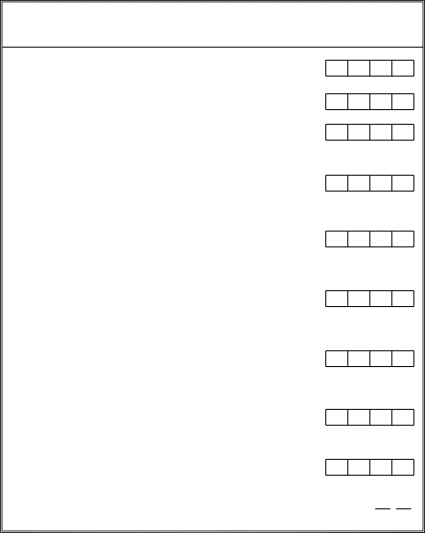 5-6
5-6
16. Does your baby successfully pick up a crumb or Cheerio by using his thumb and all his fingers in a raking motion?
(If he already picks up a crumb or Cheerio, mark “yes” for this item.)
5-8
17. Does your child pick up a small toy with the tips of her thumb and fingers? (You should see a space between the toy and her palm.)
6-8
18. After one or two tries, does your baby pick up a piece of string with her first finger and thumb? (The string may be attached to a toy.)
4-10
12 up to 18 month children start here:
19. Does your child pick up a crumb or Cheerio with the tips of his thumb and a finger? He may rest his arm or hand on the table while doing it.
5-10
Subtotal
Remember to stop when you have marked ‘Not Yet’ 3 times in a row.
ASQ
TM:Inventory
Ages & Stages Questionnaires®:Inventory
© 2009 Paul H. Brookes Publishing Co.
Fine Motor 3
Pilot Version 2.3 2011
Pilot Version 2.3 2011 Not for distribution
ASQTM: Inventory For children ages 4 weeks up to 54 months
Fine Motor
Child ID #
Program ID#
Please mark either a:
Y for Yes,
S for Sometimes, and
N for Not Yet
1st 2nd 3rd 4th
20. Does your child put a small toy down, without dropping it, and then take her hand off the toy?
6-10
21. Without resting his arm or hand on the table, does your child pick up a crumb or Cheerio with the tip of his thumb and a finger?
4-12
22. Does your child help turn the pages of a book? (You may lift a page for her to grasp.)
6-12
18 up to 24 month children start here:
23. Does your child turn the pages of a book by himself? (He may turn more than one page at a time.)
6-16
24. Does your child make a mark on the paper with the tip of a crayon (or pencil or pen) when trying to draw?
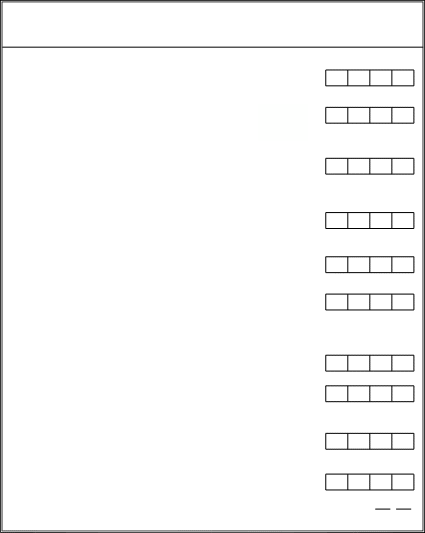 5-14
5-14
25. Does your child stack a small block or toy on top of another one? (You could also use spools of thread, small boxes, or toys that are about 1 inch in size.)
4-14
24 up to 30 month children start here:
26. Does your child flip switches off and on?
5-22
27. Does your child throw a small ball with a forward arm motion? (If he simply drops the ball, mark “not yet” for this item.)
5-12
28. Does your child stack three small blocks or toys on top of each other by herself? (You could also use spools of thread, small boxes, or toys that are about 1 inch in size.)
6-14
29. Does your child get a spoon into her mouth right side up so that the food usually doesn’t spill?
6-18
Subtotal
Remember to stop when you have marked ‘Not Yet’ 3 times in a row.
ASQ
TM:Inventory
Ages & Stages Questionnaires®:Inventory
© 2009 Paul H. Brookes Publishing Co.
Fine Motor 4
Pilot Version 2.3 2011
Pilot Version 2.3 2011 Not for distribution
ASQTM: Inventory For children ages 4 weeks up to 54 months
Fine Motor
Child ID #
Program ID#
Please mark either a:
Y for Yes,
S for Sometimes, and
N for Not Yet
30 up to 39 month children start here: 1st 2nd 3rd 4th
30. Does your child stack six small blocks or toys on top of each other by himself? (You could also use spools of thread, small boxes, or toys that are about 1 inch in size.)
5-20
31. Does your child use a turning motion with her hand while trying to turn doorknobs, wind-up toys, twist tops, or screw lids on and off jars?
6-20
32. Does your child turn pages in a book, one page at a time?
6-30
33. After your child watches you draw a single circle, ask him to make a circle like yours. Do not let him trace your circle. Does your child copy you by drawing a circle?
5-30
Count as “yes”
Count as “not yet”
39 up to 54 month children start here:
34. After your child watches you draw a line from the top of the paper to the bottom with a pencil, crayon, or pen, ask him to make a line like yours. Do not let your child trace your line. Does your child copy you by drawing a single line in a vertical direction?
3-27
35. After your child watches you draw a line from one side of the paper to the other side, ask her to make a line like yours. Do not let your child trace your line. Does your child copy you by drawing a single line in a horizontal direction?
6-27
36. Can your child string small items such as beads, macaroni or pasta “wagon wheels”, onto a string or shoelace?
6-22
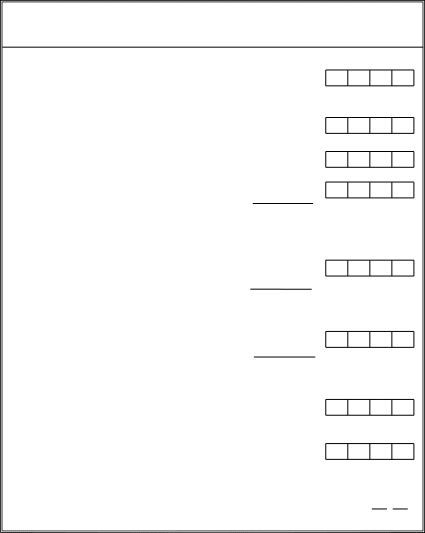 Count
as
“yes”
Count
as
“yes”
Count as “not yet”
Count as “yes”
Count as “not yet”
37. Does your child try to cut paper with child-safe scissors? She does not need to cut the paper but must get the blades to open and close while holding the paper with the other hand. (You may show your child how to use scissors. Carefully watch your child’s use of scissors for safety reasons.)
6-33
Subtotal
Remember to stop when you have marked ‘Not Yet’ 3 times in a row.
ASQ
TM:Inventory
Ages & Stages Questionnaires®:Inventory
© 2009 Paul H. Brookes Publishing Co.
Fine Motor 5
Pilot Version 2.3 2011
Pilot Version 2.3 2011 Not for distribution
ASQTM: Inventory For children ages 4 weeks up to 54 months
Fine Motor
Child ID #
Program ID#
Please mark either a:
Y for Yes,
S for Sometimes, and
N for Not Yet
1st 2nd 3rd 4th
38. When drawing, does your child hold a pencil, crayon, or pen between her fingers and thumb like an adult does?
6-36
39. Does your child put together a five to seven piece interlocking puzzle? (If one is not available, take a full-page picture from a magazine or catalog and cut it into six pieces. Does your child put it back together correctly?)
5-42
40. Does your child unbutton one or more buttons? (Your child may use his own clothing or a doll’s clothing.)
4-48
41. Using the shape at right to look at, does your child copy it onto a large piece of paper using a pencil or crayon, without tracing? (Your child’s drawing should look like the design of the shape, except it may be different in size.)
6-42
 42.
Does
your child draw pictures of people
that have at least three of the following features: head, eyes,
nose, mouth, neck, hair, trunk, arms,
hands, legs, or feet?
42.
Does
your child draw pictures of people
that have at least three of the following features: head, eyes,
nose, mouth, neck, hair, trunk, arms,
hands, legs, or feet?
5-48
43. Does your child cut up soft food into smaller pieces using a dull knife? For example, can your child use a butter knife to cut bananas or mangos? (Please supervise your child on this item.)
8p
44. Using child-safe scissors, does your child cut a paper in half on a more or less straight line, making the blades go up and down? (Carefully watch your child’s use of scissors for safety reasons.)
2-48
45. Can your child hold 5 or more playing cards so they look like a fan?
4p
Subtotal
Remember to stop when you have marked ‘Not Yet’ 3 times in a row.
ASQ
TM:Inventory
Ages & Stages Questionnaires®:Inventory
© 2009 Paul H. Brookes Publishing Co.
Fine Motor 6
Pilot Version 2.3 2011
Pilot Version 2.3 2011 Not for distribution
ASQTM: Inventory For children ages 4 weeks up to 54 months
Fine Motor
Child ID #
Program ID#
Please mark either a:
Y for Yes,
S for Sometimes, and
N for Not Yet
1st 2nd 3rd 4th
46. Does your child button large sized buttons (larger than 1/2 inch in size)?
6p
47. Can your child buckle a seat belt when riding in a car?
12p
48. Ask your child to trace on the line below with a pencil. Does your child trace on the line without going off the line more than two times? (Mark “sometimes” if your child goes off the line three times.)
4-54
49. Using the shapes below to look at, does your child copy at least three shapes onto a large piece of paper using a pencil or crayon, without trac- ing? (Your child’s drawings should look similar to the design of the shapes below, but they may be different in size.)
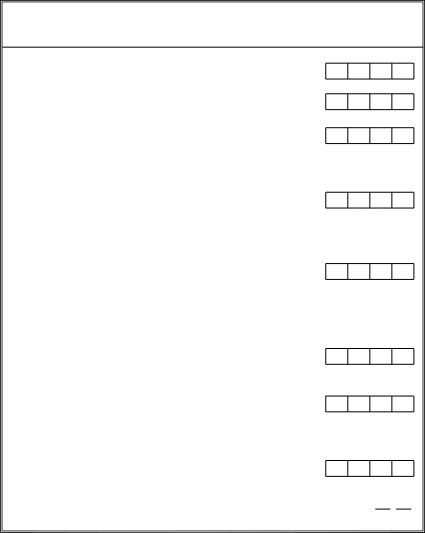 3-48
3-48
50. Ask your child to draw a picture of a person on a blank sheet of paper. You may ask your child to “Draw a picture of a girl or a boy.” If your child draws a person with head, body, arms, and legs, mark “yes.” If your child draws a person with only three parts (head, body, arms or legs), mark “sometimes.” If your child draws a person with two or fewer parts (head, body, arms, or legs), mark “not yet.”
5-54
51. Does your child color mostly within the lines in a coloring book or within the lines of a 2 inch circle that you draw? (Your child should not go more than 1/4 inch outside the lines on most of the picture.)
6-48
52. Draw a line across a piece of paper. Using child-safe scissors, does your child cut the paper in half on a more or less straight line, making the blades go up and down? (Carefully watch your child’s use of scissors for safety reasons.)
6-54
53. Can your child cut a 4 inch line across paper that is thick paper
(such as light cardboard)?
2p
Subtotal
Remember to stop when you have marked ‘Not Yet’ 3 times in a row.
ASQ
TM:Inventory
Ages & Stages Questionnaires®:Inventory
© 2009 Paul H. Brookes Publishing Co.
Fine Motor 7
Pilot Version 2.3 2011
Pilot Version 2.3 2011 Not for distribution
ASQTM: Inventory For children ages 4 weeks up to 54 months
Fine Motor
Child ID #
Program ID#
Please mark either a:
Y for Yes,
S for Sometimes, and
N for Not Yet
1st 2nd 3rd 4th
54. Using the shapes below to look at, does your child copy the shapes in the space below without tracing? (Your child’s drawings should look similar to the design of the shapes below, but they may be different in size. Mark “yes” if she can copy all three shapes; mark “sometimes” if your child can copy two shapes.)
4-60
(Copy shapes below)
55. Print your child’s first name. Can your child copy the letters? The letters may be large, backward, or reversed. (Mark “sometimes” if your child cop- ies about half of the letters.)
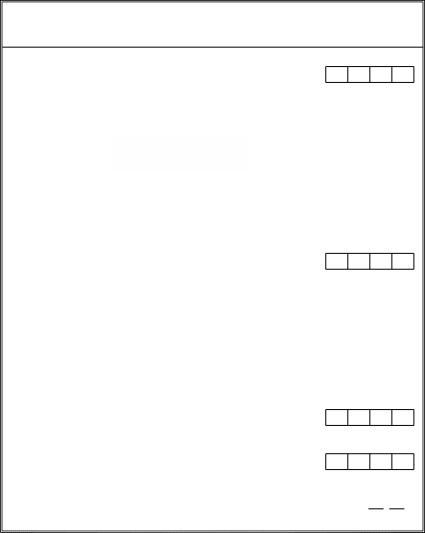 6-60
6-60
(Space for adult’s printing below)
(Space for child’s printing below)
56. Does your child cut up soft food such as banana or mango into smaller pieces using the edge of a fork?
7p
57. Give your child an 8 1/2 by 11inch piece of paper and ask him to fold the short sides together. Does your child fold the paper so that the sides match up within a half inch?
10p
Subtotal
Remember to stop when you have marked ‘Not Yet’ 3 times in a row.
ASQ
TM:Inventory
Ages & Stages Questionnaires®:Inventory
© 2009 Paul H. Brookes Publishing Co.
Fine Motor 8
Pilot Version 2.3 2011
Pilot Version 2.3 2011 Not for distribution
ASQTM: Inventory For children ages 4 weeks up to 54 months
Fine Motor
Child ID #
Program ID#
Please mark either a:
Y for Yes,
S for Sometimes, and
N for Not Yet
1st 2nd 3rd 4th
58. Does your child button most buttons on her clothing, including small but- tons less than 1/2 inch?
5p
59. Using the letters below to look at, does your child copy the letters without tracing? Cover up all of the letters except the letter being copied. (Mark “yes” if your child copies four of the letters, and you can read them. Mark “sometimes” if your child copies two or three letters, and you can read them.)
5-60
V H T C A
(Copy letters here)
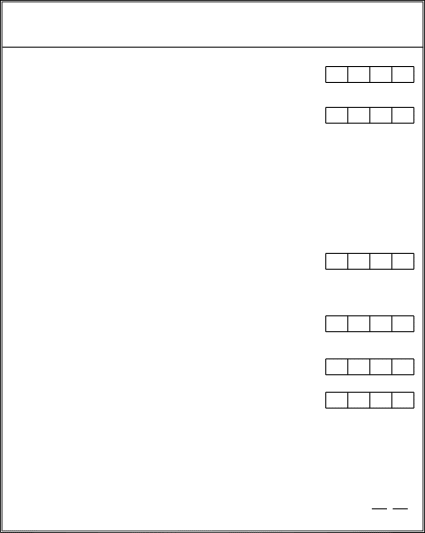 60.
Draw
a 4-inch
circle on a piece of
paper.
Does your
child use child-safe
scissors
to cut it out staying
within a 1/4
inch of
the
lines? (Carefully watch your child’s use of scissors for
safety reasons.)
60.
Draw
a 4-inch
circle on a piece of
paper.
Does your
child use child-safe
scissors
to cut it out staying
within a 1/4
inch of
the
lines? (Carefully watch your child’s use of scissors for
safety reasons.)
1p
61. Does your child cut up soft food such as banana or mango into smaller pieces using a dull knife in one hand and a fork in the other?
9p
62. Does your child successfully use a key to unlock the door?
11p
63. Can your child tie shoelaces making a bow?
3p
Subtotal
Remember to stop when you have marked ‘Not Yet’ 3 times in a row.
ASQ
TM:Inventory
Ages & Stages Questionnaires®:Inventory
© 2009 Paul H. Brookes Publishing Co.
Fine Motor 9
Pilot Version 2.3 2011
Pilot Version 2.3 2011 Not for distribution
ASQTM: Inventory For children ages 4 weeks up to 54 months
Child ID #
Program ID#
Ages & Stages Questionnaires®:Inventory
(For children ages 4 weeks up to 54 months)
Gross Motor
Instructions for completion:
1. Use the following table to find your child’s starting point based on his/her age.
2. Read each question carefully and check the box that tells whether your child is doing the activity yes (regularly), sometimes, or not yet.
3. Try each activity unless you are certain that your child can already do the item, or you know they cannot yet do the item.
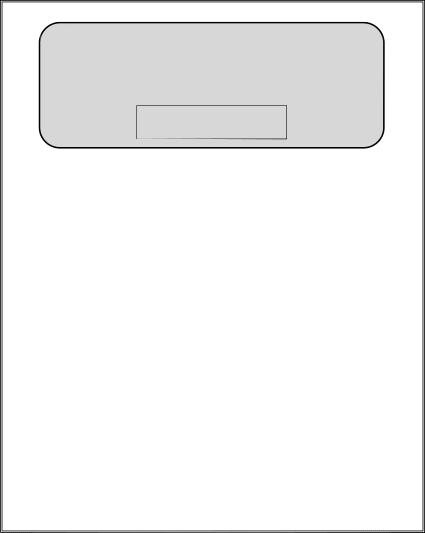 Please
note:
there
may
be
some
activities
that
your
child
used
to
do,
but
has
replaced
with
a
more
advanced
skill
(for
example,
most
children
no longer crawl after they learn to walk).
Please
note:
there
may
be
some
activities
that
your
child
used
to
do,
but
has
replaced
with
a
more
advanced
skill
(for
example,
most
children
no longer crawl after they learn to walk).
-
Starting points for the Gross Motor domain:
If your child’s age is:
Start with item:
Page:
1 up to 3 months
1
2
3 up to 6 months
5
2
6 up to 9 months
8
2
9 up to 12 months
13
3
12 up to 18 months
19
3
18 up to 24 months
24
4
24 up to 30 months
29
4
30 up to 36 months
34
5
36 up to 45 months
39
6
45 up to 54 months
45
6
Tips for completing the ASQTM:Inventory
• Try to make completing this questionnaire a game that is fun for you and your child.
• Make sure your child is rested, fed, and ready to play.
ASQTM:Inventory
Pilot Version 2.3 2011
Ages & Stages Questionnaires®:Inventory
© 2009 Paul H. Brookes Publishing Co. Pilot Version 2.3 2011 Not for distribution
Gross Motor 1
ASQTM: Inventory For children ages 4 weeks up to 54 months
Gross Motor
Child ID #
Program ID#
Please mark either a:
Y for Yes,
S for Sometimes, and
N for Not Yet
1 up to 3 month babies start here: 1st 2nd 3rd 4th
1. While your baby is on his back, does your child wave his arms and legs, wiggle and squirm?
1-2
2. When your baby is on her back, does she kick her legs?
4-2
3. After holding her head up while on her tummy, does your baby lay her head back down on the floor, rather than let it drop or fall forward?
6-2
4. When your baby is on his tummy, does he hold his head up longer than a few seconds?
3-2
3 up to 6 month babies start here:
5. While your baby is on his back, does he move his head from side to side?
5-2
6. When your baby is on her tummy, does she turn her head to the side?
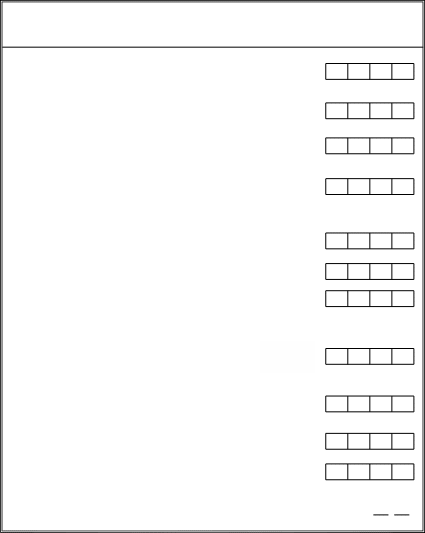 2-2
2-2
7. When you hold him in a sitting position, does your baby hold his head steady?
5-4
6 up to 9 month babies start here:
8. When your baby is on his tummy, does he hold his head up so that his chin is about 3 inches from the floor for at least 15 seconds?
3-4
9. While your baby is on her back, does she bring her hands together over her chest, touching her fingers?
6-4
10. While your baby is on his back, does your baby lift his legs high enough to see his feet?
1-6
11. When she is on her tummy, does your baby hold her head straight up, looking around? (She can rest on her arms while doing this.)
4-4
Subtotal
Remember to stop when you have marked ‘Not Yet’ 3 times in a row.
ASQ
TM:Inventory
Ages & Stages Questionnaires®:Inventory
© 2009 Paul H. Brookes Publishing Co.
Gross Motor 2
Pilot Version 2.3 2011
Pilot Version 2.3 2011 Not for distribution
ASQTM: Inventory For children ages 4 weeks up to 54 months
Gross Motor
Child ID #
Program ID#
Please mark either a:
Y for Yes,
S for Sometimes, and
N for Not Yet
1st 2nd 3rd 4th
12. When you put your baby on the floor, does she lean on her hands while sitting? (If she already sits up straight without leaning on her hands, mark “yes” for this item.)
4-6
9 up to 12 month babies start here:
13. If you hold both hands just to balance your baby, does he support his own weight while standing?
5-6
14. When your baby is on her tummy, does she straighten both arms and push her whole chest off the bed or floor?
2-6
15. Does your baby roll from his back to his tummy, getting both arms out from under him?
3-6
16. When sitting on the floor, does your baby sit up straight for several minutes without using her hands for support?
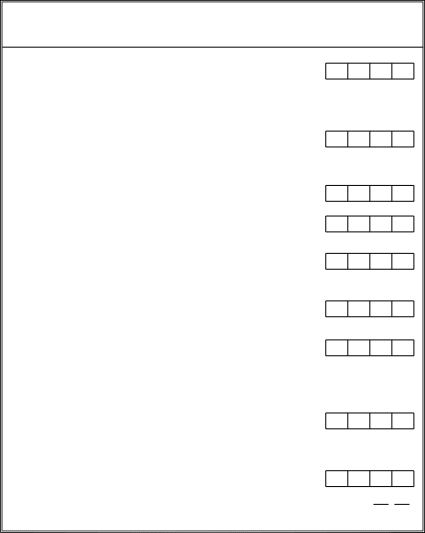 5-8
5-8
17. Does your baby get into a crawling position by getting up on her hands and knees?
6-6
18. When you stand your baby next to furniture or the crib rail, does he hold on without leaning his chest against the furniture for support?
6-8
12 up to 18 month children start here:
19. If you hold both hands just to balance your child, does he take several steps without tripping or falling? (If your child already walks alone, mark “yes” for this item.)
4-12
20. While holding onto furniture, does your child lower himself with control
(without falling or flopping down)?
5-10
Subtotal
Remember to stop when you have marked ‘Not Yet’ 3 times in a row.
ASQ
TM:Inventory
Ages & Stages Questionnaires®:Inventory
© 2009 Paul H. Brookes Publishing Co.
Gross Motor 3
Pilot Version 2.3 2011
Pilot Version 2.3 2011 Not for distribution
ASQTM: Inventory For children ages 4 weeks up to 54 months
Gross Motor
Child ID #
Program ID#
Please mark either a:
Y for Yes,
S for Sometimes, and
N for Not Yet
1st 2nd 3rd 4th
21. While holding onto furniture, does your child bend down and pick up a toy from the floor and then return to a standing position?
4-10
22. Does your child walk beside furniture while holding on with only one hand?
6-10
23. When you hold one hand just to balance your child, does she take several steps forward? (If your child already walks alone, mark “yes” for this item.)
5-12
18 up to 24 month children start here:
24. Does your child bend over or squat to pick up an object from the floor and then stand up again without any support?
5-14
25. Does your child climb onto furniture or other large objects such as large climbing blocks?
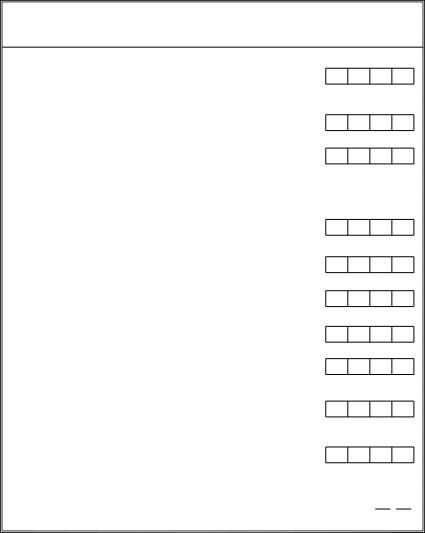 4-14
4-14
26. Does your child stand up in the middle of the floor by himself and take several steps forward?
6-12
27. Does your child move around by walking, rather than by crawling on his hands and knees?
6-14
28. Does your child walk well and seldom fall?
5-16
24 up to 30 month children start here:
29. Does your child climb on an object such as a chair to reach something she wants? (For example, to get a toy on a counter or to “help” you in the kitchen.)
6-16
30. When you show your child how to kick a large ball, does he try to kick the ball by moving his leg forward or by walking into it? (If your child already kicks a ball, mark “yes” for this item.)
6-18
Subtotal
Remember to stop when you have marked ‘Not Yet’ 3 times in a row.
ASQ
TM:Inventory
Ages & Stages Questionnaires®:Inventory
© 2009 Paul H. Brookes Publishing Co.
Gross Motor 4
Pilot Version 2.3 2011
Pilot Version 2.3 2011 Not for distribution
ASQTM: Inventory For children ages 4 weeks up to 54 months
Gross Motor
31. Does your child walk either up or down at least two steps by himself? He may also hold onto the railing or wall.
6-20
Child ID #
Program ID#
Please mark either a:
Y for Yes,
S for Sometimes, and
N for Not Yet
1st 2nd 3rd 4th
32. Does your child walk down stairs if you hold onto one of her hands? She may also hold onto the railing or wall. (You can look for this at a store, on a playground, or at home.)
5-18
33. Does your child run fairly well, stopping herself without bumping into things or falling?
5-20
30 up to 36 month children start here:
34. Without holding onto anything for support, does your child kick a ball by swinging his leg forward?
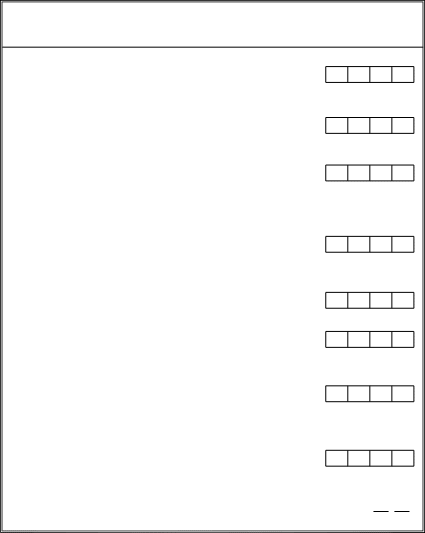 6-22
6-22
35. Does your child climb the rungs of a ladder of a playground slide and slide down without help?
6-42
36. Does your child jump with both feet leaving the floor at the same time?
5-22
37. While standing, does your child throw a ball overhand by raising his arm to shoulder height and throwing the ball forward? (Dropping the ball or throwing the ball underhand should be scored as "not yet" .)
6-33
38. Does your child walk up stairs, using only one foot on each stair? (The left foot is on one step, and the right foot is on the next.) He may hold onto the railing or wall.
6-27
Subtotal
Remember to stop when you have marked ‘Not Yet’ 3 times in a row.
ASQ
TM:Inventory
Ages & Stages Questionnaires®:Inventory
© 2009 Paul H. Brookes Publishing Co.
Gross Motor 5
Pilot Version 2.3 2011
Pilot Version 2.3 2011 Not for distribution
ASQTM: Inventory For children ages 4 weeks up to 54 months
Gross Motor
36 up to 45 month children start here:
Child ID #
Program ID#
Please mark either a:
Y for Yes,
S for Sometimes, and
N for Not Yet
1st 2nd 3rd 4th
39. Does your child jump forward at least 3 inches with both feet leaving the ground at the same time?
5-27
40. Does your child stand on one foot for about 1 second without holding onto anything?
6-30
41. While standing, does your child throw a ball overhand in the direction of a person standing at least 6 feet away? To throw overhand, your child must raise her arm to shoulder height and throw the ball forward. (Dropping the ball or throwing the ball underhand should be scored as “not yet.”)
3-48
 42.
Does
your child walk on his tiptoes for
15 feet (about the length of a large car)?
(You
may
show
him
how
to do this.)
42.
Does
your child walk on his tiptoes for
15 feet (about the length of a large car)?
(You
may
show
him
how
to do this.)
6-54
43. Does your child catch a large ball with both hands? (You should stand about 5 feet away and give your child two or three tries before you mark the answer.)
5-42
44. Does your child jump forward at least 6 inches with both feet leaving the ground at the same time?
6-36
45 up to 54 month children start here:
45. Does your child walk forward on a straight line for 10 or more steps?
10p
Subtotal
Remember to stop when you have marked ‘Not Yet’ 3 times in a row.
ASQ
TM:Inventory
Ages & Stages Questionnaires®:Inventory
© 2009 Paul H. Brookes Publishing Co.
Gross Motor 6
Pilot Version 2.3 2011
Pilot Version 2.3 2011 Not for distribution
ASQTM: Inventory For children ages 4 weeks up to 54 months
Gross Motor
46. Does your child walk down the stairs with alternating feet?
17p
Child ID #
Program ID#
Please mark either a:
Y for Yes,
S for Sometimes, and
N for Not Yet
1st 2nd 3rd 4th
47. Without holding onto anything, does your child stand on one foot for at least 5 seconds without losing his balance and putting his foot down? (You may give your child two or
three tries before you mark the answer.)
6-48
48. Does your child hop up and down on either the right or left foot at least one time without losing his balance or falling?
4-48
49. Does your child kick a ball while running and changing directions? For example, while playing soccer?
3p
50. Show your child how to walk forward by placing the heel of one foot right in front of the toe of her other foot. Can your child walk 10 or more steps forward?
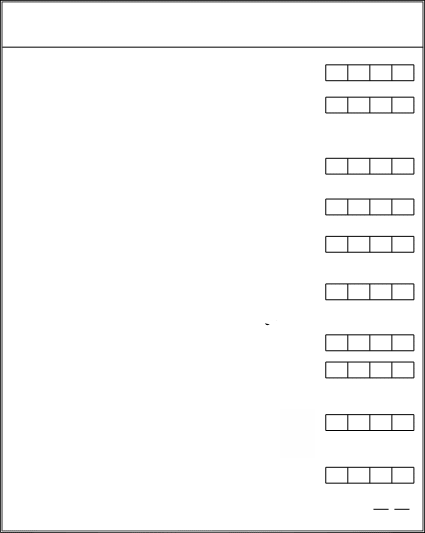 12p
12p
51. Does your child hop on one foot for a distance of 2 feet?
7p
52. Does your child jump and turn so that she faces the other way?
8p
53. Does your child hop in place on one foot for 3 times?
6p
54. Does your child jump forward a distance of 20 inches from a standing position, starting with her feet together?
5-48
55. Can your child catch a small ball (such as a tennis ball) that is thrown from
5-6 feet away?
19p
Subtotal
Remember to stop when you have marked ‘Not Yet’ 3 times in a row.
ASQ
TM:Inventory
Ages & Stages Questionnaires®:Inventory
© 2009 Paul H. Brookes Publishing Co.
Gross Motor 7
Pilot Version 2.3 2011
Pilot Version 2.3 2011 Not for distribution
ASQTM: Inventory For children ages 4 weeks up to 54 months
Gross Motor
Child ID #
Program ID#
Please mark either a:
Y for Yes,
S for Sometimes, and
N for Not Yet
1st 2nd 3rd 4th
56. Ask your child to repeat a movement pattern, such as run, jump, and skip.
Does your child do all three movements at least 2 times?
9p
57. Does your child jump forward a distance of 3 feet from a standing position? She should start with her feet together.
4p
58. Show your child how to walk backward by placing the toe of one foot in back of and touching the heel of the other. Can your child walk 10 or more steps backward?
13p
59. Does your child skip using alternating feet? (You may show her how to do this.)
6-60
60. Does your child jump on one foot 10 times, first using her right foot (5 times) and then her left foot (5 times)?
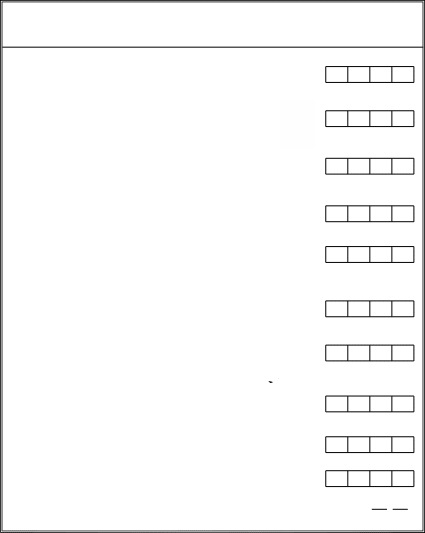 5p
5p
61. Can your child throw a small ball and hit a target that is 5-6 feet away?
20p
62. Does your child hop forward on one foot for a distance
of 4-6 feet without putting down the other foot? (You may give him two tries on each foot. Mark “sometimes” if he can hop on one foot only.)
5-60
63. Can your child swing on a swing by herself using her legs back and forth to pump.
14p
64. Can your child ride and steer a two-wheel bicycle without training wheels for at least 20 feet?
18p
65. Can your child skip rope? He should jump at least three times while flip- ping the rope over his head and under his feet.
16p
Subtotal
Remember to stop when you have marked ‘Not Yet’ 3 times in a row.
ASQ
TM:Inventory
Ages & Stages Questionnaires®:Inventory
© 2009 Paul H. Brookes Publishing Co.
Gross Motor 8
Pilot Version 2.3 2011
Pilot Version 2.3 2011 Not for distribution
| File Type | application/vnd.openxmlformats-officedocument.wordprocessingml.document |
| File Modified | 0000-00-00 |
| File Created | 0000-00-00 |
© 2025 OMB.report | Privacy Policy